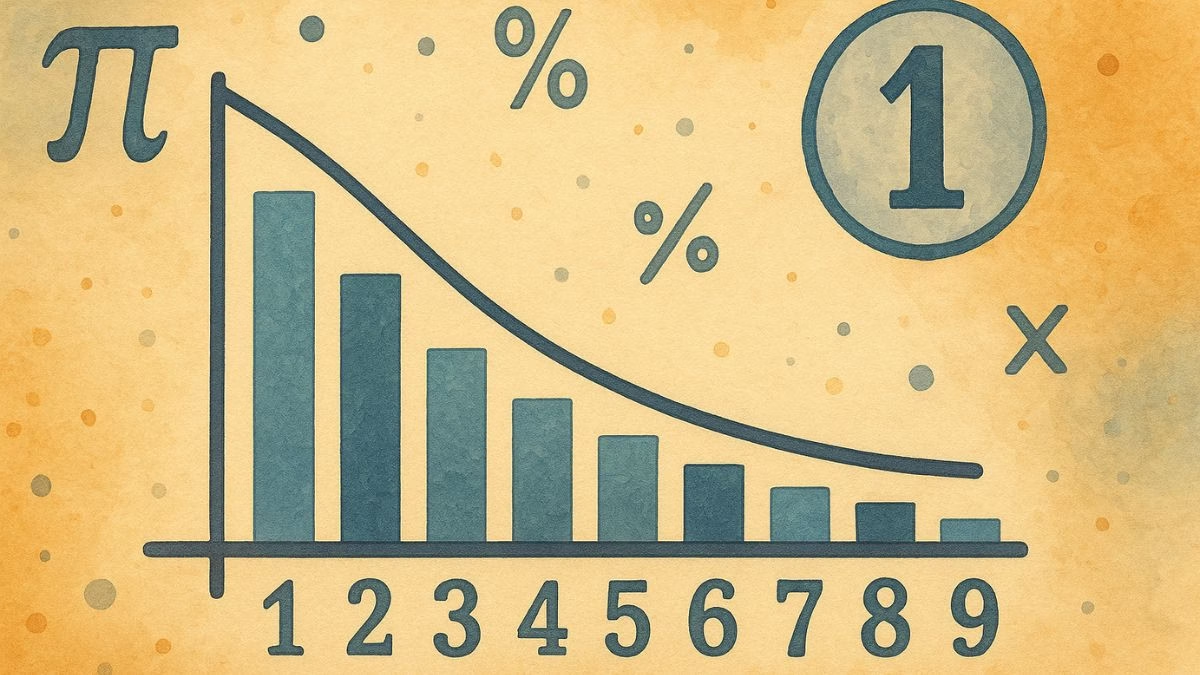Let’s play a quick game. Grab the nearest newspaper, financial report, or even a book of world statistics. Open it to a random page and point to the first number you see. What is its first digit? Is it a 1? A 7? A 9?
Now, before you answer, let’s make a bet. If I had to guess that leading digit, I would bet on 1. In fact, I would bet on 1 over and over again. And I would win about 30% of the time.
That sounds completely wrong, doesn’t it? Our intuition screams that in a random collection of numbers, all nine possible leading digits (1 through 9) should have an equal shot at appearing. Each should show up about one-ninth of the time, or 11.1%. It’s a simple, democratic, and elegant theory. And it is utterly, demonstrably false.
Welcome to the weird and wonderful world of Benford’s Law, one of the most counterintuitive, yet powerfully predictive, principles in all of mathematics. It is a hidden rule, a statistical ghost in the machine of our numerical world, that describes a profound and skewed preference for the number 1. This law is more than a mathematical curiosity; it is a powerful tool used by fraud detectors, scientists, and auditors to distinguish the natural from the fabricated. It’s a secret numerical fingerprint left by the universe itself, and once you see it, you’ll start finding it everywhere.
What in the World is Benford’s Law?
Before we get into the mind-bending “why,” let’s establish the “what.” What does this mysterious law actually state?
The Law of First Digits, Stated Simply
Benford’s Law, also known as the Law of First Digits or the First-Digit Phenomenon, states that in many naturally occurring sets of numerical data, the digit 1 appears as the leading digit with a startlingly high frequency—about 30.1% of the time. The number 2 is the first digit about 17.6% of the time, and the frequency continues to decline as the digits get larger. The humble number 9, by contrast, shows up in the lead position less than 5% of the time.
The specific probabilities are as follows:
- 1: 30.1%
- 2: 17.6%
- 3: 12.5%
- 4: 9.7%
- 5: 7.9%
- 6: 6.7%
- 7: 5.8%
- 8: 5.1%
- 9: 4.6%
This is not a wild guess; it is a mathematically precise, logarithmic distribution. It’s a cosmic bias for small numbers, a pattern that has been empirically verified in an astonishingly diverse range of data.
The Unsung Pioneers: Newcomb and Benford
Like many great scientific discoveries, this one was noticed twice. The first person to spot this anomaly was the brilliant but irascible astronomer Simon Newcomb in 1881. Newcomb was using a book of logarithm tables—this was before calculators, mind you—and he observed that the pages at the beginning of the book, those corresponding to numbers starting with 1, were far more worn, smudged, and tattered than the pages at the end. He deduced that he and his fellow scientists must be looking up numbers starting with 1 far more often than numbers starting with 9. He wrote a short paper on the phenomenon, but the idea was too strange for the time and quickly faded into obscurity.
More than fifty years later, in 1938, a physicist at General Electric named Frank Benford independently noticed the exact same thing with his own logarithm tables. Unlike Newcomb, however, Benford was tenacious. He embarked on a colossal data-gathering mission to test his hypothesis. He gathered over 20,000 data points from wildly different sources: the surface areas of 335 rivers, the populations of thousands of US cities, 308 physical constants, the street addresses of the first 342 people listed in American Men of Science, and even numbers printed in an issue of Reader’s Digest.
The pattern was unmistakable. In set after set, the number 1 showed up as the leading digit about 30% of the time. Benford meticulously documented his findings and, despite Newcomb’s earlier discovery, his name became inextricably linked to the law.
But… Why? The Counterintuitive Logic Behind the Law
This is where things get weird. Why on earth would the universe favor the number 1? The answer has to do with the nature of growth and scale. Benford’s Law applies to data that grows exponentially and/or spans several orders of magnitude (powers of 10).
The Logarithmic Scale: Thinking in Percentages, Not Amounts
Our brains tend to think linearly. We see the gap between 1 and 2 as the same size as the gap between 8 and 9. But that’s not how growth works. Growth is multiplicative, based on percentages.
Consider a fledgling company’s stock price, starting at $1. To get from $1 to $2, it has to increase by 100%. That’s a huge hurdle. The stock price will “live” in the $1-range for a significant amount of time as it struggles to achieve that 100% growth.
But once it reaches $8, what does it take to get to $9? It only needs to increase by 12.5% ($1 is 12.5% of $8). It will flash through the $8-range much more quickly on its way to $9, and then even more quickly on its way to $10, at which point the first digit resets to 1 again.
A number, as it grows, spends a disproportionate amount of time with a low leading digit because the percentage growth required to move to the next digit is much larger. This effect is at the heart of Benford’s Law.
Scale Invariance: The Magic Trick
One of the most profound properties of a Benford-compliant data set is scale invariance. This is a fancy term for a simple but magical idea: the law holds true regardless of the units you use.
Imagine you have a list of the lengths of every river in the world, measured in miles. This data set will conform beautifully to Benford’s Law. Now, what happens if you convert all those measurements to kilometers? Or to inches? Or to Smoots? It doesn’t matter. The new set of numbers will still follow Benford’s Law. The underlying distribution is so fundamental that it is not dependent on the arbitrary units we invent. This scale-free property is a hallmark of naturally generated, multiplicative data.
Where Does This Hidden Pattern Appear?
The ubiquity of Benford’s Law is what makes it so mind-boggling. Once you start looking for it, you’ll find it in the most unexpected corners of existence.
From the Cosmos to Your Checkbook
Benford’s Law accurately predicts the first-digit distribution in data sets as diverse as:
- Financial and accounting data (stock prices, company revenues, expense reports)
- Population data (city, state, and country populations)
- Scientific data (the half-lives of radioactive isotopes, physical and chemical constants)
- Geographical data (river lengths, lake surface areas, mountain heights)
- Astronomical data (distances to stars, sizes of galaxies)
- Even cultural data, like the number of Twitter followers a person has or the line-item values on a tax return.
When It Doesn’t Work: The Exceptions That Prove the Rule
Understanding where the law fails is just as important as knowing where it succeeds. Benford’s Law does not apply to data sets with built-in constraints or artificial randomness.
- Assigned numbers, like telephone numbers or zip codes, do not follow the law.
- Numbers constrained to a narrow range, like the heights or weights of adult humans, will not conform. There are no people whose height starts with a 9 (in feet) or a 5 (in meters).
- Truly random numbers, like lottery-ticket numbers, will have a flat, even distribution of first digits, just as our intuition would expect.
The data must be “naturally occurring” and span at least one or two orders of magnitude for the logarithmic pattern to emerge.
The Ultimate Fraud Detector: Benford’s Law in the Real World
This is where our esoteric mathematical principle becomes a powerful, real-world tool. The most famous application of Benford’s Law is in forensic accounting and auditing, where it is used as a highly effective litmus test for fraud.
Cooking the Books: Why Faked Numbers Look Wrong
When people fabricate data—whether it’s an employee padding an expense report or a CEO falsifying company earnings—they don’t think logarithmically. They think randomly. A fraudster inventing numbers will tend to use all the digits from 1 to 9 with roughly equal frequency because they believe that’s what a “random” or “natural” set of numbers should look like. They are trying to create data that seems inconspicuous, but in doing so, they violate the hidden Benford pattern.
If an auditor analyzes a company’s financial statements and finds that the first digits are evenly distributed, or that the number 7 appears as a leading digit 25% of the time, it is a colossal red flag. It doesn’t prove fraud on its own, but it strongly suggests that the numbers were not naturally generated and provides a powerful reason to launch a deeper investigation.
Following the Money: Benford in Forensics
Forensic accountants regularly use software that automatically checks data sets against the Benford distribution. They can use it to spot:
- Tax Fraud: A person fudging their income or deductions will likely invent numbers that don’t conform.
- Embezzlement: An employee writing fake checks to themselves might make many of them just under a certain threshold, like $5,000, leading to a surplus of 4s as the leading digit.
- Corporate Fraud: In the infamous Enron scandal, analysis of their financial data showed significant deviations from Benford’s Law, a sign of the massive fraud being perpetrated.
Beyond Finance: Other Applications
The fraud-detection principle extends far beyond money.
- Election Auditing: The vote counts from individual precincts in a fair election should largely follow Benford’s Law. If a district’s results show a bizarre spike in numbers starting with 7 or 8, it could be an indicator of ballot-box stuffing or other forms of manipulation. This was famously (though controversially) applied to the 2009 Iranian presidential election.
- Scientific Integrity: The law can be used to check scientific data for potential fabrication.
- Public Health Data: Analysts have even applied Benford’s Law to daily COVID-19 case numbers from various countries to spot potential anomalies or inconsistencies in reporting.
Conclusion: The Secret Poetry of Numbers
Benford’s Law is a beautiful testament to the hidden order that underlies our often-chaotic world. It is a mathematical echo of how things grow, spread, and are measured. It reminds us that even in a spreadsheet full of financial data or a list of river lengths, there is a secret, logarithmic poetry at play.
It’s more than a party trick; it’s a powerful lens that helps us to see the world differently. It provides a baseline for what “natural” looks like, giving us a tool to spot the artificial, the manipulated, and the fraudulent. So the next time you browse a catalog or scan a report, pay attention to the first digits. You are witnessing a ubiquitous and profound mathematical truth, a secret handshake between you and the numerical structure of the universe. And it all started with a dirty book of logarithms.
Focus on Language
Vocabulary and Speaking
Let’s zoom in on some of the language from that article on Benford’s Law. When you’re trying to explain a concept that is a bit strange or goes against what people expect, the words you use are critical. They have to be precise, but also evocative enough to make the idea stick. Let’s break down some of the key vocabulary we used and explore how you can use these words to sound more articulate and persuasive.
A word we used right away to describe Benford’s Law is counterintuitive. This is a fantastic word. Something that is counterintuitive goes against what you would expect or what your gut feeling tells you is true. The idea that 1s are more common than 9s is deeply counterintuitive. The idea that a heavier object and a lighter object fall at the same speed in a vacuum is also counterintuitive. You can use this word anytime you’re describing an idea that seems wrong at first glance but is actually correct. “It’s counterintuitive, but sometimes taking a break can make you more productive than working straight through.”
To describe the strange pattern Newcomb first noticed, we called it an anomaly. An anomaly is something that deviates from what is standard, normal, or expected. It’s an irregularity or a peculiarity. If you get a sudden, unexplained spike in your website traffic, that’s an anomaly worth investigating. A surprisingly warm day in the middle of winter is a climatic anomaly. It’s a great, formal word for an oddity or something that doesn’t fit the pattern.
We said that Frank Benford’s name became inextricably linked to the law. Inextricably means in a way that is impossible to separate or disentangle. It signifies a very deep and fundamental connection. You might say that in a global economy, the fates of different countries are inextricably linked. Or that for many artists, their personal identity is inextricably tied to their work. It’s a powerful adverb to use when you want to show that two things are fundamentally bound together.
To describe Frank Benford himself, we used the word tenacious. A tenacious person is someone who is very determined and does not give up easily. They are persistent. Benford was tenacious in his quest for data to prove his theory. You might describe a successful entrepreneur as tenacious because they kept going despite many failures. A lawyer might have a tenacious approach to cross-examining a witness. It’s a very positive word for someone with grit and persistence.
A key reason Benford’s Law works is because it applies to data sets that are ubiquitous. Ubiquitous is a wonderful word that means present, appearing, or found everywhere. In today’s world, smartphones have become ubiquitous. The influence of American pop culture is ubiquitous around the globe. It’s a more sophisticated way to say something is “everywhere” or “very common.”
We referred to the law as a kind of litmus test for fraud. A litmus test is literally a test using litmus paper to determine if a substance is acidic or alkaline. Metaphorically, a litmus test is any single, decisive factor or event that can be used to make a judgment or a decision about something. A politician’s vote on a key issue might be a litmus test for their true beliefs. How a company treats its lowest-paid employees could be a litmus test for its corporate culture. It means a quick, decisive test.
When fraudsters invent numbers, they are trying to make them look inconspicuous. Inconspicuous means not conspicuous; not clearly visible or attracting attention. It’s the quality of blending in. A spy might try to dress in an inconspicuous way to avoid being noticed. A small, inconspicuous sign is easy to miss. Fraudsters try to create inconspicuous data, but Benford’s Law can reveal their efforts.
Of course, Benford’s Law has its caveats. We’ve seen this word before, and it’s so useful it’s worth repeating. A caveat is a warning or a specific condition that needs to be considered. We explained the caveats to Benford’s Law—the types of data it doesn’t apply to. You might say, “I’ll lend you my car, with the caveat that you have to bring it back with a full tank of gas.” It’s a formal and precise way to add a condition or a warning.
In the end, we called the law a profound mathematical truth. Something that is profound is very great, intense, or deep. It can describe an emotion (profound sadness), a thought (a profound insight), or an effect (a profound change). It suggests a level of seriousness and intellectual or emotional depth. The discovery of DNA had a profound impact on biology. It’s a word you use for things of great significance.
Lastly, we used the word esoteric. An esoteric idea or subject is one that is intended for or likely to be understood by only a small number of people with a specialized knowledge or interest. The detailed rules of quantum mechanics can seem very esoteric to a non-physicist. Before it was widely applied, Benford’s Law was a rather esoteric mathematical principle. It implies something is specialized, niche, and not commonly known.
Now, for our speaking section. Today’s skill is making the complex simple. Benford’s Law is a great example of a topic that can sound very academic and esoteric. To make it understandable, we have to connect it to things people already know. We used the analogy of the stock price growth and the river. This is a critical communication skill.
The key is to avoid jargon and find a relatable metaphor.
- Isolate the core principle: What’s the one thing you need them to understand? For Benford’s Law, it’s that growth isn’t linear; it’s logarithmic.
- Translate jargon: Instead of “logarithmic,” say “It’s about percentage growth.” Instead of “orders of magnitude,” say “growing from 10 to 100 to 1000.”
- Build a metaphor: The stock price example is great. It’s something people have a concept of. You could also use a metaphor of climbing a ladder where the rungs get closer together as you go higher.
Here’s your challenge this week. Think of a concept from your work, your studies, or a hobby that is a little bit esoteric or complex. Your mission is to prepare a one-minute explanation of it for a complete beginner. Your goal is to use zero jargon. Instead, you must create a simple analogy or metaphor to get the main idea across. Try to use a word like counterintuitive or profound to frame why it’s interesting. Record yourself. Then, listen back. Would your grandmother understand it? Would a 10-year-old get the gist? This skill of translating the complex into the simple is a communication superpower.
Grammar and Writing
The Writing Challenge
Benford’s Law is a powerful tool because it provides a baseline for what “natural” data looks like, allowing us to spot the “artificial” or manipulated. This idea of having a baseline to detect anomalies isn’t just for numbers; it applies to many areas of life, from spotting a fake smile to identifying a disingenuous political argument.
For this writing challenge, your task is to write a 500-750 word essay on the topic: “Developing Your Own ‘Benford’s Law’ for Life.”
In your essay, choose one specific area of life where people often present a false or fabricated front (e.g., social media profiles, corporate mission statements, political speeches, first dates, job interviews).
Your essay should:
- Describe the “natural baseline” for this area. What does authentic, genuine behavior or communication typically look like? What are its characteristics?
- Describe the “unnatural deviations.” When people are being fake or manipulative in this context, what are the tell-tale signs? What “red flags” (like the surplus of 7s in fraudulent data) do they exhibit?
- Explain how “testing” against your baseline can help you navigate this area of life more wisely. How can you use your personal “Benford’s Law” to better detect authenticity?
Your goal is to use the logic of Benford’s Law as a metaphor for developing critical thinking and intuition in a non-mathematical context.
A Grammar and Writing Lesson to Ace Your Essay
Writing an essay that builds an extended metaphor requires careful control over your language to ensure the comparison remains clear and compelling. You need to guide your reader through a complex idea gracefully. Let’s look at some grammatical structures and stylistic choices that can help you succeed.
Part 1: The Power of the Adverbial Clause
An adverbial clause is a group of words that functions as an adverb. It tells you how, why, when, or under what condition an action takes place. These clauses, often starting with words like because, although, since, while, if, and when, are essential for building logical arguments and comparisons.
- To show cause (Why): You need to explain why fabricated behavior deviates from the norm.
- “Because humans are psychologically poor at faking randomness, their invented numbers often look unnatural.”
- In your essay: “Because people on a first date are trying to present an idealized version of themselves, their stories often lack specific, mundane details.”
- To show contrast (Under what condition): You need to contrast the natural baseline with the fake behavior.
- “While naturally occurring data follows a logarithmic curve, fabricated data tends to be flat.”
- In your essay: “Whereas a genuine corporate culture is reflected in everyday employee actions, a fabricated one exists only in glossy mission statements.”
Using these clauses at the beginning of your sentences adds variety and sophistication, immediately signaling the logical relationship between your ideas.
Part 2: Using Parentheses and Dashes for Asides and Emphasis
Good writing often contains multiple layers of thought. Parentheses ( ) and em-dashes (—) are two powerful punctuation marks that allow you to insert extra information, asides, or clarifications into your sentences without disrupting the main flow.
- Parentheses ( ) for non-essential asides: Use parentheses to tuck in extra details, definitions, or humorous asides that are helpful but not critical to the sentence’s meaning.
- “Simon Newcomb first noticed the phenomenon in 1881 (long before calculators were a thing), but his work was largely ignored.”
- In your essay: “An authentic social media profile often includes a mix of polished photos and candid, less-than-perfect moments (we all have bad hair days).”
- Em-dashes (—) for emphasis or dramatic interruption: Use em-dashes to set off a phrase you want to emphasize or to create a more dramatic break in thought. They feel more energetic than parentheses.
- “He gathered data from wildly different sources—river lengths, city populations, even numbers in Reader’s Digest.”
- In your essay: “There is one tell-tale sign of a disingenuous politician—an absolute refusal to answer the question directly.”
Mastering these two marks will give your writing more personality and allow you to control the rhythm and emphasis of your sentences.
Part 3: The Art of the Analogy and Simile
Since your entire essay is an extended metaphor (Your Rule vs. Benford’s Law), reinforcing it with smaller, more vivid comparisons (similes and analogies) will make your writing more engaging and clear.
- Simile (using “like” or “as”):
- “For an auditor, a deviation from Benford’s Law is like a flare in the night sky; it doesn’t tell you everything, but it tells you exactly where to look.”
- In your essay: “A corporate mission statement full of buzzwords without action is like a store with a beautiful sign but empty shelves.”
- Analogy (a more developed comparison):
- “Benford’s Law acts as a filter. It cannot see the motivation behind the numbers, it can only report on whether their pattern is consistent with the physics of natural growth.”
- In your essay: “My rule for spotting inauthenticity on social media acts as a similar filter. It can’t know the person’s true feelings, but it can detect when the pattern of their posts—all flawless victories and perfect vacations—is inconsistent with the messy reality of a genuine human life.”
These figurative comparisons make abstract ideas concrete and memorable for your reader, which is the key to a successful analytical essay. By weaving these grammatical and stylistic tools into your writing, you can create a piece that is not only well-argued but also a pleasure to read.
Let’s Learn Vocabulary in Context: The Quiz
Let’s Discuss
- The “Unnatural” Human Brain:
- Benford’s Law works because it reflects natural, multiplicative growth. Humans, when faking data, fail to replicate this and create evenly distributed numbers. What does this say about our own intuition? Are our brains “wired” to think linearly rather than logarithmically? Let’s discuss other areas where our intuition leads us astray compared to the mathematical reality of the world.
- A Universal Law?
- The article mentions Benford’s Law appearing in everything from river lengths to physical constants. This implies a deep, underlying mathematical structure to the universe. Does this discovery make the universe feel more orderly and predictable to you, or more mysterious and strange? Let’s discuss our emotional and philosophical reactions to discovering such a hidden, universal pattern.
- The Ethics of a “Fraud Detector”:
- Benford’s Law has been used to flag potential election fraud and corporate crime. But it’s a statistical tool, not definitive proof. What are the ethical implications of using a mathematical law to accuse someone of wrongdoing? Let’s discuss the pros and cons, and where the line should be between a “red flag” and a formal accusation.
- Finding Benford in Your Own Life:
- Now that you know about the law, where might you expect to find it in your own daily life? Think about the numbers you generate or encounter. Would the number of emails you receive each day follow the law over a year? What about the prices of items in your online shopping cart? Let’s brainstorm some personal “data sets” we could test.
- Beyond the First Digit:
- Benford’s Law also extends to second, third, and even last digits (though the distributions are different and less skewed). This suggests that many numbers are not random at all. How does this idea challenge our concept of “randomness”? Is anything in the real world truly random, or is it just a product of complex systems we don’t fully understand?
Learn with AI
Disclaimer:
Because we believe in the importance of using AI and all other technological advances in our learning journey, we have decided to add a section called Learn with AI to add yet another perspective to our learning and see if we can learn a thing or two from AI. We mainly use Open AI, but sometimes we try other models as well. We asked AI to read what we said so far about this topic and tell us, as an expert, about other things or perspectives we might have missed and this is what we got in response.
As a mathematician specializing in probability and statistics, I find that Benford’s Law is one of the most delightful gateways into deeper mathematical thinking. The article you’ve just read is an excellent summary of the core concepts, but I’d love to add a few details that really highlight its mathematical elegance and some of its more subtle properties.
First, let’s touch upon the mathematical foundation more formally, but still simply. The article mentions the law is “logarithmic,” and that’s the key. The actual formula for the probability of a digit ‘d’ being the first digit is P(d) = log₁₀(1 + 1/d). If you plug in d=1, you get log₁₀(2), which is 0.301, or 30.1%. If you plug in d=9, you get log₁₀(1 + 1/9), which is log₁₀(1.111…), which is 0.046, or 4.6%. The reason this logarithmic pattern emerges is linked to the distribution of numbers on a logarithmic scale (like a slide rule). On a log scale, the distance from 1 to 2 is the same as the distance from 2 to 4, or 4 to 8. The space occupied by numbers starting with “1” (the distance from 1 to 2) is a huge chunk of the total scale, while the space for numbers starting with “9” (the distance from 9 to 10) is a tiny sliver at the very end. Data that grows multiplicatively spreads out evenly over this logarithmic scale, so it naturally spends more “time” in the bigger regions.
Second, I want to expand on the concept of scale invariance because it’s so profound. The article mentions that changing units (miles to kilometers) doesn’t break the law. But there’s another invariance that’s just as important: base invariance. The law as we know it is for our base-10 number system. But what if we humans had evolved with eight fingers and used a base-8 system? Benford’s Law would still hold, but the probabilities would be different. The distribution of first digits is a fundamental property of any valid base-representation system. This proves that the phenomenon isn’t a weird quirk of the number 10; it’s a much deeper principle about how numbers and scales work, regardless of how we choose to write them.
Finally, let’s talk about the second-digit law. Benford’s analysis didn’t stop at the first digit. He found that the distribution of second digits also follows a predictable, though less dramatic, pattern. Unlike the first digit, the second digit can be 0. The distribution for second digits is much flatter, with 0 being the most common at about 12%, and the probabilities gently declining to about 8.5% for the digit 9. This extends to third, fourth, and subsequent digits, which become progressively flatter until their distribution is almost perfectly uniform. This is incredibly useful for fraud detection. A smart fraudster might know about the first-digit law and try to fake it, but they almost never know about the second-digit law. A sophisticated analysis that checks the distribution of the first two digits is an even more powerful litmus test for fabrication. It shows that the non-randomness isn’t just at the beginning; it’s a pattern that echoes, more faintly, through the entire number.
So, when you think of Benford’s Law, remember the simple elegance of the log formula, the deep principle of base invariance, and the powerful, subtle extension of the law to subsequent digits. It takes it from a neat curiosity to a truly fundamental principle of mathematics.










0 Comments